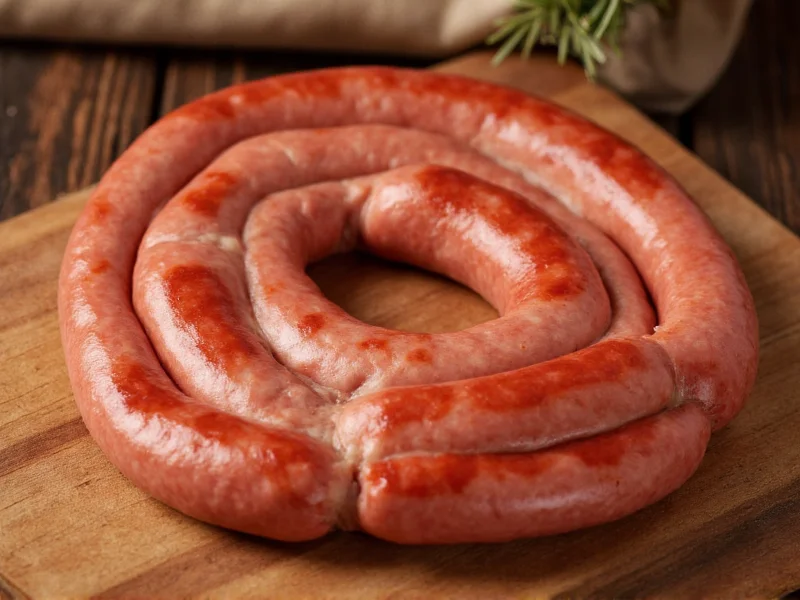As a distinctive element of Central European culinary heritage, kolbasz represents more than just a sausage—it embodies centuries of tradition, regional variations, and cultural significance. This smoked meat product has evolved through generations of butchers perfecting their craft, adapting to local tastes while maintaining core preparation methods that define authentic kolbasz.
What Exactly Is Kolbasz Sausage?
The term "kolbasz" (also spelled kolbász in Hungarian) derives from the Turkish word "kolbaşı," reflecting historical influences on Hungarian cuisine. Unlike many sausages that prioritize garlic or fennel, authentic kolbasz features paprika as its signature seasoning, giving it a distinctive reddish hue and complex flavor profile ranging from sweet to hot depending on the paprika variety used.
Traditional kolbasz preparation follows strict methods: high-quality meat (primarily pork shoulder or belly) is coarsely ground, mixed with salt, black pepper, and generous amounts of paprika, then stuffed into natural casings. The critical step that defines kolbasz is the smoking process, typically using beech or oak wood over several days, which preserves the sausage while developing its characteristic smoky flavor.
Regional Variations of Kolbasz Sausage
While Hungarian kolbasz remains the most recognized version, neighboring countries have developed their own interpretations:
| Region | Distinctive Characteristics | Preparation Method |
|---|---|---|
| Hungarian | Rich paprika flavor, medium coarseness | Hot smoked (60-80°C), often dried |
| Polish | Less paprika, more garlic, coarser grind | Cold smoked, often fully dried |
| Czech/Slovak | Milder paprika, sometimes caraway | Hot smoked, usually semi-dry |
| Romanian | Spicier, with more black pepper | Hot smoked with beech wood |
How Kolbasz Differs From Similar Sausages
Many confuse kolbasz with Polish kielbasa, but key differences exist. While both are smoked sausages from Central Europe, traditional Hungarian kolbasz features paprika as its dominant seasoning, whereas kielbasa typically emphasizes garlic and marjoram. The texture also differs—authentic kolbasz has a finer grind than most kielbasa varieties.
Compared to German bratwurst or Italian sausages, kolbasz stands apart through its distinctive paprika-forward flavor profile and specific smoking techniques. German sausages often feature different spice blends (like nutmeg or mace), while Italian sausages typically highlight fennel and red pepper flakes—neither incorporates paprika as centrally as authentic kolbasz.
Culinary Applications of Kolbasz Sausage
Kolbasz's versatility makes it valuable in numerous traditional dishes. In Hungary, it features prominently in kolbászleves (sausage soup) and lecsó (a paprika-based vegetable stew). Polish preparations often include it in bigos (hunter's stew) or served simply grilled with mustard and rye bread.
When cooking with smoked kolbasz sausage, remember it's already fully cooked through the smoking process. The best preparation methods include:
- Grilling: Slice diagonally and grill until slightly charred
- Boiling: Simmer in beer or broth for enhanced flavor
- Stewing: Add to bean dishes or vegetable soups during last 20 minutes
- Pan-frying: Slice and fry until edges crisp for sandwiches
For those seeking authentic Hungarian kolbasz preparation at home, traditional recipes call for a specific ratio of pork to fat (typically 70:30), smoked over beech wood for 24-48 hours, then air-dried for several weeks. Modern home cooks often adapt by using liquid smoke and oven smoking techniques when traditional smoking facilities aren't available.
Identifying Quality Kolbasz
When selecting authentic kolbasz sausage, look for these quality indicators:
- Natural casing with slight irregularities (machine-perfect casings suggest mass production)
- Deep, rich red color from quality paprika (avoid unnaturally bright red)
- Firm texture that springs back when pressed
- Distinct smoky aroma without sour or chemical notes
- Minimal visible fat separation
Traditional Hungarian kolbasz should list only meat, salt, paprika, and other natural spices in its ingredients—avoid products with artificial colors, preservatives, or fillers if seeking authentic regional variations of kolbasz sausage.
Storage and Food Safety
Proper storage maintains both safety and quality of kolbasz. Fully dried varieties can be stored at room temperature for weeks in a cool, dry place. Semi-dry and fresh kolbasz requires refrigeration and should be consumed within 7-10 days. For longer storage, wrap tightly in butcher paper and freeze for up to 3 months.
When preparing kolbasz, remember that traditional smoked varieties are fully cooked, though many prefer heating them before serving. Always inspect for signs of spoilage—discoloration, slimy texture, or sour odor indicate the sausage should be discarded.
Frequently Asked Questions
What's the difference between kolbasz and kielbasa?
Kolbasz is Hungarian in origin with paprika as the dominant seasoning, while kielbasa is Polish with garlic and marjoram as primary flavors. Kolbasz typically has a finer grind and distinctive red color from paprika, whereas kielbasa often has a coarser texture and brownish hue.
Is kolbasz sausage already cooked?
Traditional smoked kolbasz is fully cooked through the smoking and drying process. It can be eaten as-is, though many prefer heating it before serving to enhance flavors and texture. Always check packaging instructions as preparation may vary by product.
What gives kolbasz its distinctive red color?
The characteristic red color comes from high-quality Hungarian paprika, which is central to authentic kolbasz preparation. The specific variety of paprika (sweet, semi-sweet, or hot) determines both the color intensity and flavor profile of the sausage.
Can I make kolbasz sausage at home?
Yes, though traditional preparation requires specialized equipment. Home cooks can create simplified versions using quality pork, Hungarian paprika, salt, and natural casings. The critical elements are proper meat-to-fat ratio (70:30), correct seasoning proportions, and adequate smoking time. Many adapt by using liquid smoke and oven methods when traditional smoking isn't feasible.
How should I store kolbasz sausage?
Fully dried kolbasz can be stored at room temperature in a cool, dry place for several weeks. Semi-dry varieties require refrigeration and should be consumed within 7-10 days. For longer storage, wrap tightly in butcher paper and freeze for up to 3 months. Always inspect for signs of spoilage before consumption.











 浙公网安备
33010002000092号
浙公网安备
33010002000092号 浙B2-20120091-4
浙B2-20120091-4